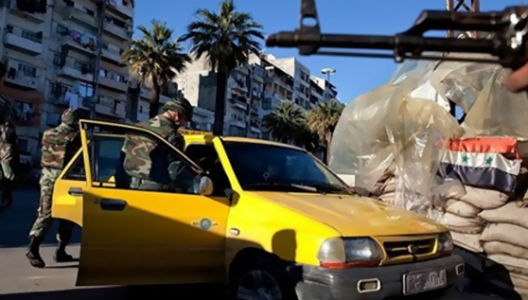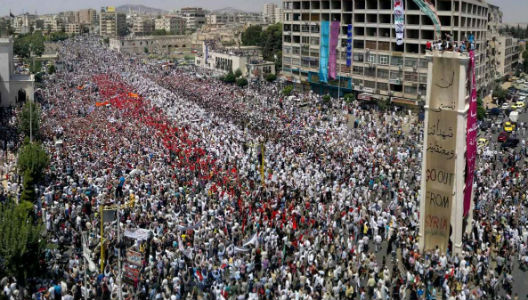 In light of the ongoing war, the conflict approaching the city of Hama, and the increasing displacement of people from the countryside, the regime has adopted a policy of re-engineering the population to ensure a base of popular support in city centers. This policy exacerbates the suffering of people currently living in the Hama region, and increases the possibility of humanitarian crisis. Residents have few options: they cannot flee to the east because of ISIS’ presence there, there is increasing violence in the north around Aleppo, and the coastal regions, the only relatively safe place left in the country, are already overwhelmed with displaced persons.
In light of the ongoing war, the conflict approaching the city of Hama, and the increasing displacement of people from the countryside, the regime has adopted a policy of re-engineering the population to ensure a base of popular support in city centers. This policy exacerbates the suffering of people currently living in the Hama region, and increases the possibility of humanitarian crisis. Residents have few options: they cannot flee to the east because of ISIS’ presence there, there is increasing violence in the north around Aleppo, and the coastal regions, the only relatively safe place left in the country, are already overwhelmed with displaced persons.
The city of Hama in central Syria is faced with conflict again, as Syrian opposition forces have taken control of three important villages in the countryside north of Hama and are approaching the edges of the city itself. As the battle intensifies, there are only 25 km between them and the city, and more than 10,000 civilians have been displaced and fled for neighboring regions in the past two weeks.
Hama is a strategic site for the embattled parties: it is located in the center of the country, and is a hub for transport between important provinces including Aleppo, Homs, Lattakia, and Deir Ezzor. It also has significant historical importance for opposition fighters, as the city that witnessed the largest massacre in modern history. In 1982, Hafez al-Assad, former President of Syria and the father of Bashar al-Assad, killed between 10,000 and 40,000 residents of the city when quelling a Muslim Brotherhood uprising.
The regime has tried to control the city since the events of 2011 and the conflict in Syria began, forbidding local residents from going out to demonstrate in opposition to President Bashar al-Assad. Despite this, Hama witnessed some of the largest demonstrations against the Assad regime, when nearly 500,000 protesters filled the streets in July 2011 and demanded transition to democratic rule in Syria.
 Photo: Picture from a citizen journalist of the July 8, 2011 protest that, according to local sources, had 500,000 participants. The regime responded violently to these protests; Syrian security forces moved into the city of Hama with tanks, and taking full control of it on August 3, 2011. They detained thousands of members of the opposition and threw them in prison, imposed military checkpoints in the middle of the city, and posted security forces at the entrances.
Photo: Picture from a citizen journalist of the July 8, 2011 protest that, according to local sources, had 500,000 participants. The regime responded violently to these protests; Syrian security forces moved into the city of Hama with tanks, and taking full control of it on August 3, 2011. They detained thousands of members of the opposition and threw them in prison, imposed military checkpoints in the middle of the city, and posted security forces at the entrances.
As a result, thousands of local residents of the city were displaced, according to Hama journalist Abada Qujan. They were forced to flee because of their support for the peaceful protest movement, while the regime recruited militias loyal to it, including foreign ones like Hezbollah from Lebanon.
Assad’s forces have controlled the city since 2011, and have continued to hunt down civil society activists and displace local residents, says Qujan. They have pursued and detained so many young men that thousands more have fled to neighboring countries, for fear of being detained, or to areas outside the Assad regime’s control, which is what Qujan himself has done.
One example of the displacement policy the regime has pursued to change the face of the city and restructure the population, as Qojan relates, is that Assad’s forces bombed and destroyed the Masaa al-Arbaeen neighborhood. Masaa al-Arbaeen was a historical district in the northeast part of Hama city. As a result, about 30,000 residents were forced to flee. Most went to other neighborhoods and nearby regions, as Assad’s forces did not allow them to return to the destroyed neighborhood after it imposed control on the district, under the pretext that the residents supported opposition forces.
According to Qujan, the regime has continuously terrorized and detained residents of Hama since 2011, and has relied on a policy of terrorizing youth by tracking and detaining them. The number of activists pursued by security forces have forced them to leave the city. The last peaceful demonstration in Hama was held four years ago, on the thirtieth anniversary of the Hama Massacre, when several activists painted several streets and dyed the Orontes River red.
While there are no precise statistics from human rights organizations about the number of detainees in Hama province, which includes the city of Hama and rural areas, figures from the Documentation Center and Revolutionary Council of Hama indicate that there are over 40,000 detainees, half of whom are in the city.
A few days before the Syrian regime restarted its security campaign, activists received news that the regime had sent warnings to some residents in neighborhoods of the old city of Hama to leave their houses. The regime claimed that they had not obtained security approval for their residency there, or that they were living in informal housing. Most residents were displaced persons whose homes in other neighborhoods had been destroyed.
Regime forces “evicted a number of families from neighborhoods south of the stadium and the Aleppo road. They occupied several houses in neighborhoods south of the stadium and in al-Sabonya, and evicted the families without providing any reason or compensation,” says Khaled al-Hamwi, a journalist and activist in the Hama Opposition Media Center.
“Fighters from Lebanese Hezbollah and soldiers from Shiite militias settled in houses owned by local families who had been displaced, preventing them from returning,” al-Hamwi added.
“There are nearly 250 checkpoints in Hama; every street in the city has at least two check points. Recently, regime forces seized the highest building in every neighborhood, whether it had been a government facility or belonged to civilians, and turned these buildings into main checkpoints, surrounded by heavy artillery and snipers, and in control of other checkpoints throughout each neighborhood.”
In addition to military barracks and security checkpoints, Hama has one of the largest military airports, which is used to bomb northern Syria, and there is also a large Russian and Iranian military presence in surrounding villages, according to accounts by several activists and media professionals.
Hama is the fourth largest city in Syria, and has a population of around 854,000 according to 2009 figures. The city has become the destination for thousands of internally displaced persons in Syria, as it has long been relatively far from military operations.
According to statistics from 2015 from the Syrian Red Crescent, a non-governmental organization, nearly 400,000 people have fled to the city of Hama from the provinces of Raqqa, Homs, and Deir Ezzor since the conflict began. They endure harsh living conditions, and most rely on aid given to them by relief agencies.
This suffering is not limited to displaced persons, but also includes the city’s original residents. According to Maher al-Youssef, a resident of the city of Hama, economic conditions and public services have become increasingly strained as the city has come under the control of militias fighting for the regime. They take advantage of civil society organizations and aspects of life, while the government has abandoned its responsibilities. Houses receive only five hours of electricity per day, fuel prices have multiplied, kidnapping and crime rates have increased, and militiamen have become the only residents who can sustain their livelihoods.
Hosam al-Jablawi is a Syrian citizen journalist.
Image: Photo: Syrian regime checkpoint in Hama.
